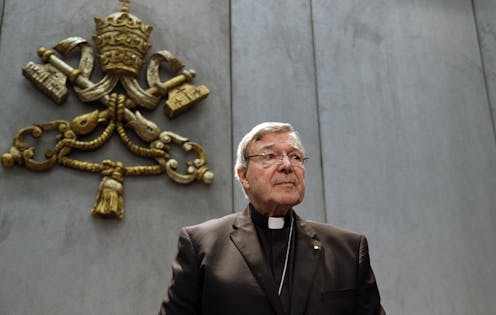Why have media outlets been fined more than $1 million for their Pell reporting?
- Written by Rick Sarre, Emeritus Professor of Law and Criminal Justice, University of South Australia

In February, Australian media companies pleaded guilty[1] to contempt of court over their reporting of Cardinal George Pell’s conviction on sexual abuse charges.
On Friday, the Victorian Supreme Court handed out more than A$1 million[2] in fines against 12 media organisations.
The most heavily hit were the The Age ($450,000) and news.com.au ($400,000). Other high-profile programs, such as the Today Show also copped fines ($30,000). These heavy fines were meted out despite the fact that the media companies had apologised to the court and had even agreed to pay the prosecution’s legal costs[3].
There are many ways the law restricts media freedom in Australia, including laws regarding defamation[4]. But contempt of court, seen here by the media’s breaching of a suppression order, is one of the more controversial mechanisms[5]. It is, however, a limitation the courts impose regularly, and take very seriously.
How did this start?
Back in December 2018, the court placed a suppression order on the Pell conviction when he was initially found guilty by a jury (his conviction was quashed in April 2020[6]).
At the time, various media outlets referred to a trial of great importance and, by implication, a guilty verdict that would have been of great interest to the public.
Read more: The jury may be out on the jury system after George Pell's successful appeal[7]
The implicit, not explicit, nature of the reporting raises an important point. No Australian media company actually named Pell, but some directed their audiences to international online stories. The Herald Sun published a white headline “CENSORED” across a black front page, thereby piquing Victorians’ interest in seeking out international media reports and internet commentary.
As the paper reported,
The world is reading a very important story that is relevant to Victorians.
The point is had any member of the public wanted to find out what the media were talking about, they could have done so.
Why did the court issue the order?
So why was there a suppression order on the conviction?
This was to try and ensure a fair trial. At the time of the guilty verdict in December 2018, Pell was also facing a second trial over different charges related to similar alleged conduct. Ultimately, as it happened, the second trial did not proceed after charges against Pell were dropped in February 2019. But the possibility of a second trial was alive at the time of the first trial guilty verdict.
There is a principle in law that a jury must decide guilt or innocence on the basis of the evidence before them, and not to allow other evidence (for example, a conviction for a similar crime) to taint their deliberations.
So it was important a jury in that second trial (had it gone ahead) could not know of the first conviction. Otherwise, it would be breaking the rule against using “similar fact evidence[8]”.
The rules are clear
Suppression orders are a significant limitation[9] on the freedom of the press to report what happens in our criminal courts, but they exist to guarantee that people who come before the courts get a fair trial.
Contempt of court is a serious offence and can result in jail time. Indeed, journalists have been jailed in the past for similar indiscretions. However, no action was ultimately pursued against individuals here. The court determined the appropriate penalty was for fines to be imposed on media organisations.
Read more: When a fair trial could be at risk, suppression is the order of the day[10]
In contempt matters, the amount of any fine is open-ended and, in this case, we see very heavy penalties. This is because Justice John Dixon took a dim view of what he surmised were the motives of the media corporations.
He said The Age and news.com.au articles[11] especially
constituted a blatant and wilful defiance of the court’s authority […] each took a deliberate risk by intentionally advancing a collateral attack on the role of suppression orders in Victoria’s criminal justice system.
In his view[12] the “timing” of the media apology – made contemporaneously with the contempt guilty plea – “did not demonstrate any significant degree of remorse and contrition.”
The judge added media companies had not only usurped the function of the court, but had taken it “upon themselves” to decide “where the balance ought to lie” between the cardinal’s right to a fair trial and the public’s right to know about it.
While people might debate the politics and huge public interest in the Pell case, the law is clear — that balance is a matter for the courts and the courts alone to determine.
References
- ^ pleaded guilty (www.theage.com.au)
- ^ handed out more than A$1 million (www.theguardian.com)
- ^ pay the prosecution’s legal costs (www.theguardian.com)
- ^ defamation (theconversation.com)
- ^ controversial mechanisms (www.minterellison.com)
- ^ quashed in April 2020 (theconversation.com)
- ^ The jury may be out on the jury system after George Pell's successful appeal (theconversation.com)
- ^ similar fact evidence (www.lexisnexis.co.uk)
- ^ significant limitation (www.theguardian.com)
- ^ When a fair trial could be at risk, suppression is the order of the day (theconversation.com)
- ^ The Age and news.com.au articles (www.abc.net.au)
- ^ his view (www.theguardian.com)

















